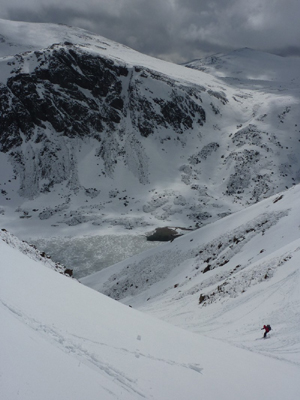Impacts of volcanic ash originating from the eruption in Eyjafjallajökull (Iceland) on the natural resources of Scotland
Published on 8 February 2011 in Climate, water and energy , Ecosystems and biodiversity

Introduction
The fall out of volcanic ash from the eruption of the Icelandic volcano Eyjafjallajökull caused significant travel disruption during April 2010 and raised specific concerns about the potential impacts on Scottish natural resources, such as (i) pastures and livestock; (ii) soils and (iii) surface water. This research note addresses these concerns. It is based upon post-eruption data collected from a number of sites in the Scottish uplands and current scientific opinion. Volcanic eruptions result in substantial emissions of gases (e.g. CO2 and SO2) and ash particles. The varying characteristics of ash between volcanoes and individual eruptions and the consequent transport patterns increase uncertainty of predicting the impact of ash fall across Scotland.
Key Points
The main eruption at Eyjafjallajökull was visually confirmed on 14th April 2010 and has been monitored regularly by the Institute of Earth Sciences, University of Iceland. It has been suggested that the eruption, although not insignificant at a maximum 30000 tonnes of CO2 day-1, will not make a substantial addition to global anthropogenic atmospheric CO2 emissions. The majority of the ash from the recent eruption appears to be composed of fine grained glass particles, which can be dispersed widely from the eruption site.
The main risks are to livestock through fluoride ingestion from volcanic ash on pasture. Indications are that the volcanic ash layer deposited in Scotland was thin (< 5 mm), and effects on pasture and soils are negligible.Measurable effects to surface waters would be associated with increased fluoride concentrations derived from ash that has fallen directly onto water surfaces and acidification episodes caused by increased sulphate deposition in rainfall and snow reaching rivers and lakes. Ongoing rainfall and surface water data from long-term Environmental Change Network (ECN) monitoring sites in Scotland (Fig. 1) have allowed a comparison between pre and post eruption conditions: it is clear in these areas that not enough ash was deposited to have any negative effects on water quality.
Higher altitude and areas of Scotland prone to acidification are potentially more sensitive to increased inputs from the volcanic eruption. This may lead to surface waters experiencing more acidic conditions than otherwise expected during snowmelt or high rainfall as rapid runoff bypasses mitigating mechanisms (buffering) within soils. Moreover, seasonality of deposition can have a major bearing on the associated risk of negative impacts, such as impacts that coincide with when freshwater fish, such as trout and salmon are most vulnerable or crops are planted.
|
Fig. 1a
Glensaugh (ECN site) weather station near stream
|
Fig. 1b
Sourhope (ECN site) weather station
|
.jpg) |
.jpg) |
| Photo: Carol Taylor | Photo: Carol Taylor |
Research Undertaken
Surface water and precipitation (rainfall/snow) chemistry has been collated by the Macaulay Land Use Research Institute from 2 long-term ECN monitoring sites (Glensaugh in NE Scotland and Sourhope in the Borders) in order to address potential affects of the volcanic eruption. Pre and subsequent 6 months post eruption data (e.g. pH, sulphate, fluoride, dissolved organic carbon, major cations and trace metals) have been compared. As fresh snowfall occurred across the Cairngorms shortly after the eruption, surface snow samples were also collected at 5 different sites from the Cairngorm plateau on 18th and 24th April towards the end of a period of the significant snowfall (Fig. 2). Post-eruption data indicated that some volcanic glass shards were present in Scottish rainfall and snow consistent with the composition of the Eyjafjallajökull magma (Fig. 3). However, there were little measurable effects in surface waters in this instance compared to pre-eruption data.
|
Fig. 2
Snow sampling from Cairngorm in April 2010
|
Fig. 3
Scanning electron microscopy image of volcanic glass from snow |
 |

Photo: Evelyne Delbos |
| Photo: Scott Muir |
Policy Implications
The continued maintenance of an established monitoring network is essential for comparative analysis such as this as well as determining mechanisms that drive long-term variability and processes in vegetation, soils and surface waters. The historic and continued post eruption monitoring of dissolved components and particulate material in rainfall/snow and surface waters from sensitive upland areas will ensure that any unforeseen changes away from the norm are detected. If prolonged eruptions occur in the future, there may be increased contributions in deposition in comparison with what occurs naturally and through long-distance anthropogenic pollution at the present time. This will be important in the event of more substantial Icelandic volcanic eruptions, e.g. Katla, which would be expected to eject from 10-100 times more ash than the recent eruption at Eyjafjallajökull.
Author
Julian Dawson, Evelyne Delbos, Rupert Hough, David Lumsdon, Bob Mayes & Helen Watson j.dawson@macaulay.ac.uk
Topics
Climate, water and energy , Ecosystems and biodiversity







